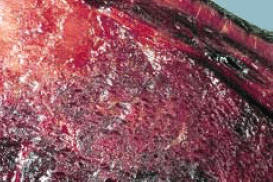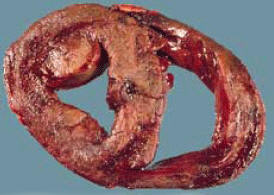



Blackleg in cattle
By Dr Sarah Robson Regional Animal Health Leader, Animal & Plant Biosecurity, Wagga Wagga and J.M. Wilson Former District Veterinarian, Rural Lands Protection Board and published by NSW DPIIntroduction
Blackleg is a fatal disease of young cattle. It produces an acute local infection, and the resulting blood poisoning leads to rapid death.The name ‘blackleg’ derives from the fact that the site of infection is often a leg muscle, and that the affected muscle is dark in colour.
Occurrence of blackleg
Although the disease is widely distributed in New South Wales, most losses from blackleg occur in the eastern half of the state. In some areas the disease may appear on several properties, while in other areas only isolated farms are affected. Sometimes, only part of a property is affected.Susceptible animals
Although blackleg has been found in cattle as young as 2 months old, most losses occur in cattle between 6 months and 2 years of age. Occasionally, losses are seen in adult cattle.Generally, the best conditioned animals are affected, with most losses occurring where there is an abundance of feed.
Blackleg can occur at any time of the year, though more losses are seen during hot, humid weather or following the sudden onset of cold periods.
Cause
Blackleg is produced by spore-forming bacteria. The organisms most commonly responsible are Clostridium chauvoei and, less frequently, C. septicum. Spores produced by the clostridia can lie dormant in the soil for years without losing their potency.Method of infection
Bacterial spores are eaten in contaminated feed or soil. The spores then enter the bloodstream and lodge in various organs and tissues, including muscles. Here they lie dormant until stimulated to multiply, possibly by some slight injury to the animal. The injury reduces blood flow to the area, thereby reducing the supply of oxygen to the tissues. In the absence of oxygen, the spores germinate and multiply. As they grow, the bacteria produce toxins which destroy surrounding tissues. The toxins are absorbed into the animal’s bloodstream which makes the animal acutely sick and causes rapid death.Signs of the disease
Blackleg should be suspected if an animal aged between 6 months and 2 years:- becomes lame with swelling of a muscle;
- stops grazing;
- appears sick and quickly goes down.
However, these signs are usually of such short duration that they may be missed. More frequently, a thrifty calf or yearling is simply found dead. Gas is detectable under the skin and this produces a crackling sensation when the skin is rubbed with the hand.

|
| Figure 1.Diseased skeletal muscle |
If the skin over the affected area is removed, excess bubbly bloodstained fluid can be seen, and the muscle immediately below will be dark in colour. However, when the affected muscle is inside the carcass, such as when the heart muscle is affected, no external evidence of the disease is found.
Figure 1 shows diseased skeletal muscle from a heifer that died suddenly from blackleg. The muscle tissue is dark red and has a dry appearance due to gas formation.

|
| Figure 2. Diseased heart muscle Photos: Roger Cook, NSW DPI |
Because the disease is accompanied by rapid decomposition, the post-mortem changes may be masked by gas formation, especially if examination of the carcass is delayed for more than a few hours.
The only effective means of controlling blackleg is by vaccination. Several makes of multivalent vaccine (‘5 in 1’ or ‘7 in 1’) are available commercially and care should be taken to follow the manufacturer’s instructions.
Always read the label
Users of agricultural or veterinary chemical products must always read the label and any Permit before using the product, and strictly comply with the directions on the label and the conditions of any Permit. Users are not absolved from compliance with the directions on the label or the conditions of the Permit by reason of any statement made or not made in this publication.
- Calves should receive two doses of blackleg vaccine. Two vaccinations 1 month apart are essential to provide the best protection.
- A booster vaccination 12 months later should provide lifelong immunity to blackleg.
- It is desirable to give the initial two doses of vaccine before young cattle reach their most susceptible age of six months.
- To await the occurrence of blackleg before vaccinating is unwise, as vaccines take 10–14 days before they begin to provide immunity.
If store cattle are purchased in blackleg areas, it is wise to vaccinate all newly bought young cattle.
Vaccination techniques
The vaccine should be delivered just under the skin – not into the muscle. Draw up a pinch of skin and insert the needle between the skin and the muscle. The loose skin of the neck is convenient for this. (See Primefact 431 Beef cattle vaccines for correct vaccination technique.)
Do not save unused parts of bottles or containers of vaccines for future use, as they can become contaminated with undesirable organisms and/or lose their potency. Destroy any vaccine not used within 24 hours of opening.
Vaccination breakdowns
Modern vaccines are produced under conditions of strict quality control by reputable manufacturers. Occasionally, reports are received of apparent failure of vaccines. When investigated, most of these alleged vaccination failures are due to:- incorrect dosing;
- faulty technique;
- using time-expired vaccine;
- using material from partly used containers;
- vaccine having been subjected to high temperatures during storage or transportation.
Abscesses or large swellings at the site of vaccination are usually the result of:
- lack of hygiene;
- injecting into muscle rather than beneath the skin.
If all these factors can be ruled out, and breakdown is suspected, seek veterinary advice.
Treatment
The speed with which blackleg kills usually makes individual treatment useless. In some cases, however, animals treated early with antibiotics may survive, although they often suffer permanent deformity due to partial or complete destruction of muscles.Carcass disposal
Carcasses of animals known to have died from blackleg should not be opened. Opening the carcass can liberate bacteria which will form spores that will contaminate the ground and subsequently infect other cattle.Also, do not drag carcasses along the ground. If possible, burn or deeply bury the carcasses where they lie.
Remember
- Blackleg is almost entirely preventable by vaccination .
- Read – and heed – the directions on the vaccine labels.
- If in doubt about the cause of deaths in cattle, consult your veterinary practitioner, district veterinarian or veterinary officer .


